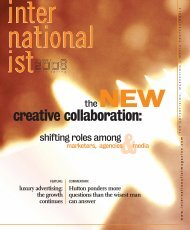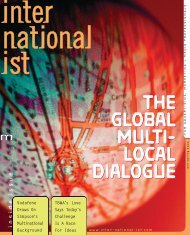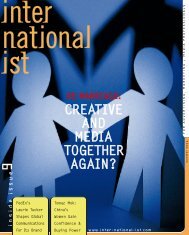2011 Issue 55 - Internationalist
2011 Issue 55 - Internationalist
2011 Issue 55 - Internationalist
You also want an ePaper? Increase the reach of your titles
YUMPU automatically turns print PDFs into web optimized ePapers that Google loves.
Three Tips for Improved Cultural Agility<br />
In what direction are you most likely to read?<br />
If our brains are hard-wired by the language we first<br />
learn as small children; and if our first imprinting is<br />
to read left to right, like English, we have a potential<br />
disconnect with people who are oriented toward<br />
reading down, right-to-left, like those who read<br />
Mandarin. We English speakers have a disconnect if<br />
we are looking for the verb in the middle of the<br />
sentence structure when our relationship person<br />
has been programmed to see the verb at the<br />
beginning of the sentence like readers of many<br />
Latin languages—or, at the end of a sentence, as is<br />
the case with Japanese. In English the pen we write<br />
with is an “it.” But, in other languages one has to<br />
first decide if “it” is a male or female, before<br />
cognition is achieved.<br />
My friend David Tang, who leads DDB Singapore<br />
reminds me that “People are quick to talk about<br />
similarities but we are slow to grasp differences.”<br />
This is a key principle at play between young<br />
netizen consumers and older marketers, Western<br />
brands in Asia, and also Asian brands getting into<br />
the West. Also for worldwide brands trying to ‘do’<br />
local markets. It’s a big shift towards the importance<br />
of local insights, languages even as the world<br />
becomes more connected.<br />
Language is a technology, our first and most<br />
personal technology. Once technology is mastered, it<br />
becomes invisible to us. Remember setting up your<br />
first BBerry, iPhone or VCR? At first the technology<br />
was very visible, difficult even. But, as you became<br />
more familiar in using it, it became invisible.<br />
1) Treat language difference with more reverence.<br />
Don't be afraid to ask individuals you are<br />
attempting to communicate with a) what<br />
language did they grow up speaking at home and<br />
b) what language do they think in and/or which<br />
they count numbers in. We are finding even as a<br />
person learns different languages, they still count<br />
in the language they first learned.<br />
Another tip for language versatility: Always ask<br />
questions and invite dialogue, and build (two-way<br />
conversations, instead of a one-way missive). This<br />
changes the way agencies do our work. Instead of<br />
launching one big campaign at one go, this<br />
becomes a series of sequential, ever-interacting<br />
modules<br />
2) When using an interpreter, slow way down and<br />
use crisp sound bytes followed by quiet for the<br />
translator to better/more accurately do their job—<br />
eg.to translate ideas. Avoid colloquialisms, they<br />
don’t translate well. Remember, when faced with<br />
uncertainty people generally think defensively.<br />
3) Learn how to say hello, please, thank you in the<br />
language of your communications partner. It will<br />
sharpen your mind (people who speak more than<br />
one language tend to have reduced onset of<br />
Alzheimer’s and dementia). It will remind you of<br />
the gap in understanding which you need to<br />
respect in order to win friends and influence<br />
people.<br />
In the stream of communications technology<br />
which is ever flowing, all information flows into<br />
and out from individuals, with an undertow of<br />
misinformation that has never been stronger. And,<br />
we all come to the stream with our own language<br />
impediment.<br />
www.internationalistmagazine.com<br />
39










